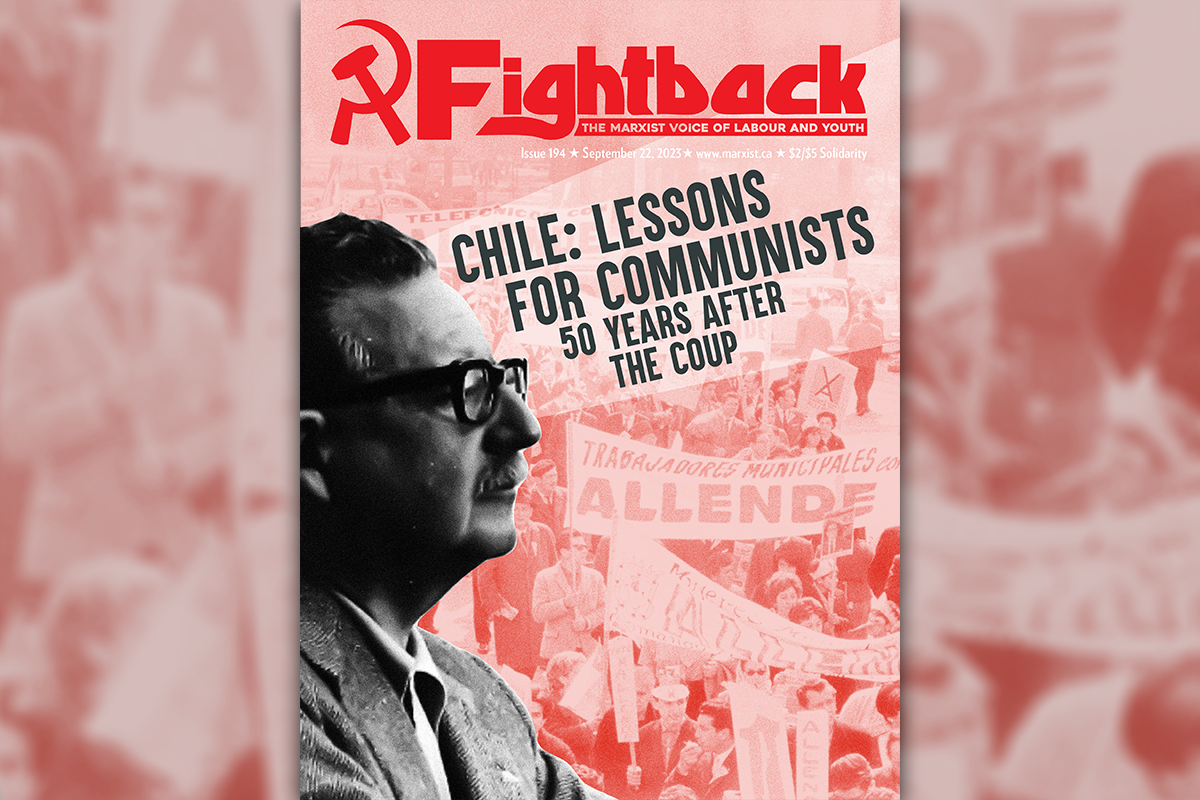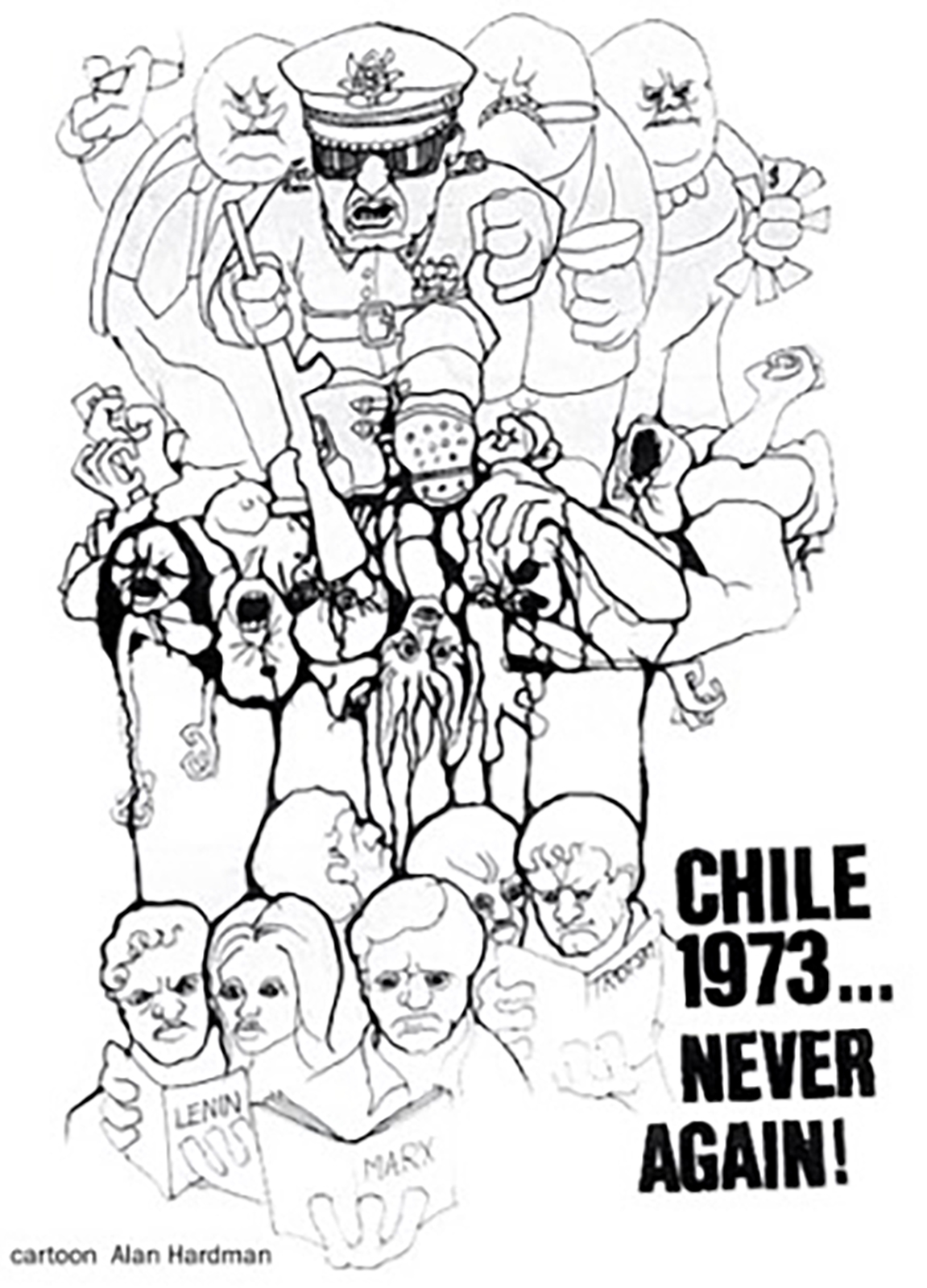
Issue #194 of Fightback is out now! In this editorial, Benoît Tanguay discusses the lessons of the 1973 coup in Chile for communists today. The issue also includes an in-depth article on Allende, the coup, and and what came after for Chile; as well as articles on declining life expectancy, striking casino workers, the Temporary Foreign Workers program, and unionizing VFX workers. We are also excited to introduce a new section in the paper, “The Spectre of Communism”, that brings together lessons and experiences for communists across the country!
Reform or revolution? The answer to this question may seem obvious to the young communists who read this magazine. “Easy: Revolution! Next question!”
But history shows us that the difference between reform and revolution is not always so clear-cut in the real world.
The history of Chile, where the 50th anniversary of Pinochet’s brutal coup d’état is being commemorated this month, is an example of the danger that awaits those who fail to distinguish between the two. As was the case with socialist leader Salvador Allende, reform sometimes takes on a revolutionary garb. It’s crucial for communists to understand what separates the two phenomena.
At the time of the coup d’état on Sept. 11, 1973, Chile was in the midst of a revolutionary process. Everywhere, in workplaces, schools, universities, and households, people were discussing politics. In the factories, workers were studying Capital and Karl Marx’s labour theory of value. The masses of workers and peasants wanted socialism and trembled with impatience, seizing land and building organs of struggle and workers’ control.
The situation corresponded perfectly with Trotsky’s famous aphorism that “the most indubitable feature of a revolution is the direct interference of the masses in historical events.”
Faced with the immense revolutionary energy of the masses, their tireless mobilization, the leaders of the Popular Unity government headed by Allende had no choice but to speak in revolutionary language, to speak of socialism and revolution.
In his first speech to the Chilean parliament after his election, in September 1970, the new president Allende declared:
“Speaking frankly, our task is to define and put into practice, as the Chilean road to socialism, a new model of the State, of the economy and of society which revolves around man’s needs and aspirations… There are no previous experiments that we can use as models – we shall have to develop the theory and practice of new forms of social, political and economic organization, both in order to break with under-development and create socialism… If we should forget that our mission is to establish a social plan for man, the whole struggle of our people for socialism will become simply one more reformist experiment.”
But Allende’s actions did not match his words. For all his declarations in favor of revolution and socialism, he remained a reformist in deeds.
Allende’s government had undertaken a number of nationalizations, notably of the copper mines, one of the most important sectors of the Chilean economy. But socialization progressed slowly, step by step. The economy, and in particular distribution, remained essentially in the hands of capitalists.
This enabled them to carry out a campaign of economic sabotage and lockouts to bring down the Chilean economy. The capitalists will never allow the socialist transformation of the economy, however gradual.
Capitalism is based on private ownership of the means of production. The essential act of socialist revolution is the expropriation of the capitalists. Without this, capitalists retain control of the economy, the source of their power. There can be no socialism without the destruction of capitalists as a class, through the expropriation of the capitalists. This is the only way to arrive at a communist society—a classless society.
To pull the legs out from under the bourgeoisie, a general appeal should have been made to the workers to take control of the industries. That was all they were waiting for. But while the working masses courageously embarked on the road of expropriations, occupying businesses time after time, Allende’s government blocked their path, demanding a gradual development of the revolution. But a revolution is like a bicycle: it needs to pick up a certain speed if it is not to fall over. By trying to slow down the tempo of the revolution, Allende was condemning it to failure.
The socialist revolution is also the introduction of democracy into the economy, with workers taking control of the economy through workers’ councils in factories. Such democracy makes it possible to put an end to the anarchy of the market and to proceed with the democratic planning of the economy by the workers. While Chilean workers had spontaneously begun to take the businesses into their own hands to build such a democracy, Allende’s government relied instead on parliamentary democracy, naively imagining that they could control it.
But parliamentary democracy is an institution designed entirely to serve the bourgeois ruling class. At every turn, the state—the courts, the departments, the police, the army—undermined and sabotaged the efforts of the nominally ruling Popular Unity. The task of a revolution is not to rely on parliamentary democracy, but to abolish it and replace it with what Lenin called the “real democracy of the toilers”—a democracy based on workers’ councils in every workplace.
The upper echelons of the state—high-ranking officers, police chiefs, senior civil servants, judges—are bound by a thousand and one threads to the capitalist class. Allende believed that these people had some loyalty to “democracy” and would come to save him from the putschists, whereas their loyalty was (and always will be) to the bourgeoisie. They themselves were the coup plotters.
In reality, the Popular Unity government controlled the bourgeois state in much the same way as a man gripping the barrel of a gun pointed at him: it was still the bourgeoisie that had its finger on the trigger.

Rather than relying on “constitutionalists” in the armed forces, a revolution must rely on the strength of organized, armed workers. The bourgeois state cannot be reformed—it must be abolished, to be replaced by a workers’ state. Failure to understand this cost Allende, and thousands of other revolutionaries, their lives.
The tragedy of the Chilean revolution clearly demonstrates one cannot make half a revolution. The road of history is littered with the corpses of leaders like Allende who spoke of revolution, but were not prepared to see it through to the end: expropriation of the capitalists, democratic planning of the economy as a whole, smashing the capitalist state, and establishing a workers’ state. The result is the same every time: a bloody defeat.
As we enter an era of revolutions, young communists today must remember the lessons of Chile. Increasingly, under the pressure of mass radicalization, leaders will emerge who speak a revolutionary language. But this is not enough. Without a clear understanding of capitalism, its institutions and its functioning, and of the tasks of socialist revolution, even the best-intentioned leaders risk being shipwrecked, like a ship without a compass. The best guarantee of victory for the revolution lies in building a mass revolutionary party armed with the guide of Marxism.

